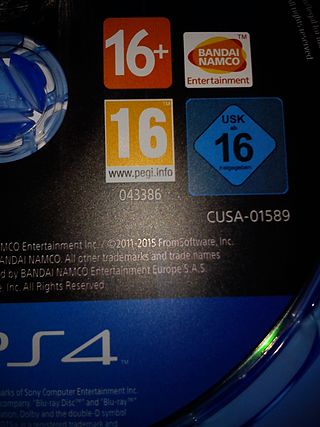Related Research Articles
A motion picture content rating system classifies films based on their suitability for audiences due to their treatment of issues such as sex, violence, or substance abuse, their use of profanity, or other matters typically deemed unsuitable for children or adolescents. Most countries have some form of rating system that issues determinations variously known as certifications, classifications, certificates, or ratings. Age recommendations, of either an advisory or restrictive capacity, are often applied in lieu of censorship; in some jurisdictions movie theaters may have a legal obligation to enforce restrictive ratings.

The Entertainment Software Rating Board (ESRB) is a self-regulatory organization that assigns age and content ratings to consumer video games in the United States and Canada. The ESRB was established in 1994 by the Entertainment Software Association, in response to criticism of controversial video games with excessively violent or sexual content, particularly after the 1993 congressional hearings following the releases of Mortal Kombat and Night Trap for home consoles and Doom for home computers. The industry, pressured with potential government oversight of video game ratings from these hearings, established both the IDSA and the ESRB within it to create a voluntary rating system based on the Motion Picture Association of America film rating system with additional considerations for video game interactivity.
In video games, censorship are efforts by an authority to limit access, censor content, or regulate video games or specific video games due to the nature of their content. Some countries will do this to protect younger audiences from inappropriate content using rating systems such as the ESRB rating system. Others will do this to censor any negative outlook on a nation's government.

The Office of Film and Literature Classification, branded as the Classification Office, is an independent Crown entity established under Films, Videos, and Publications Classification Act 1993 responsible for censorship and classification of publications in New Zealand. A "publication" is defined broadly to be anything that shows an image, representation, sign, statement, or word. This includes films, video games, books, magazines, CDs, T-shirts, street signs, jigsaw puzzles, drink cans, and slogans on campervans. The Chief Censor, Caroline Flora, is the chair of the Office.
The Ontario Film Review Board is an inactive agency of the government of the Canadian province of Ontario that was formerly responsible for that province's motion picture rating system. Until 2015, the board reported to the Minister of Consumer Services but as of 1 October 2015, the board was overseen by the Ontario Film Authority. The board's activities were based on the Film Classification Act, 2005.
The Saskatchewan Film and Video Classification Board is a board of the Saskatchewan Department of Justice responsible for providing film and video classification documents to movie theatres in the Canadian province of Saskatchewan. The Board was formerly responsible for reviewing films and granting film ratings, but since 1 October 1997 these duties have been done by the British Columbia Film Classification Office on Saskatchewan's behalf.
The Maritime Film Classification Board is a government organization responsible for reviewing films and granting film ratings in New Brunswick, Nova Scotia and Prince Edward Island.

The Irish Film Classification Office (IFCO) is the organisation responsible for films, television programmes, and some video game classification and censorship within Ireland. Where restrictions are placed by the IFCO, they are legally binding.
The British Columbia Film Classification Office, part of Consumer Protection BC in the Canadian province of British Columbia, is responsible for rating and censoring films under the province's Motion Picture Act. The BCFCO film ratings are also used by Manitoba and Saskatchewan by bilateral agreement.
Censorship in Singapore mainly targets political, racial, religious issues and homosexual content as defined by out-of-bounds markers.
A content rating rates the suitability of TV shows, movies, comic books, or video games to this primary targeted audience. A content rating usually places a media source into one of a number of different categories, to show which age group is suitable to view media and entertainment. The individual categories include the stated age groups within the category, along with all ages greater than the ages of that category.

The Movie and Television Review and Classification Board is a Philippine government agency under the Office of the President of the Philippines that is responsible for the classification and review of television programs, motion pictures and home videos.

A video game content rating system is a system used for the classification of video games based on suitability for target audiences. Most of these systems are associated with and/or sponsored by a government, and are sometimes part of the local motion picture rating system. The utility of such ratings has been called into question by studies that publish findings such as 90% of teenagers claim that their parents "never" check the ratings before allowing them to rent or buy video games, and as such, calls have been made to "fix" the existing rating systems. Video game content rating systems can be used as the basis for laws that cover the sales of video games to minors, such as in Australia. Rating checking and approval is part of the game localization when they are being prepared for their distribution in other countries or locales. These rating systems have also been used to voluntarily restrict sales of certain video games by stores, such as the German retailer Galeria Kaufhof's removal of all video games rated 18+ by the USK following the Winnenden school shooting.
Motion picture ratings in Canada are mostly a provincial responsibility, and each province has its own legislation regarding exhibition and admission. For home video purposes, a single Canadian Home Video Rating System rating consisting of an average of the participating provincial ratings is displayed on retail packages, although various provinces may have rules on display and sale, especially for the R and A categories.

British Board of Film Classification is a non-governmental organisation founded by the British film industry in 1912 and responsible for the national classification and censorship of films exhibited at cinemas and video works released on physical media within the United Kingdom. It has a statutory requirement to classify all video works released on VHS, DVD, Blu-ray, and, to a lesser extent, some video games under the Video Recordings Act 1984. The BBFC was also the designated regulator for the UK age-verification scheme which was abandoned before being implemented.
The Film Classification Act, 2005 is a statute which governs motion picture and computer game ratings in the province of Ontario, Canada. The law also provides the legal basis for the activities of the Ontario Film Review Board. Prior to this, film censorship and classification in Ontario was mandated first by the Theatres and Cinematographs Act, 1911 then the Theatres Act, 1953.
The Australian Classification Board is an Australian government statutory body responsible for the classification and censorship of films, video games and publications for exhibition, sale or hire in Australia. The ACB was established in 1970 and was once part of the Office of Film and Literature Classification (OFLC), which was dissolved in 2006. The Department of Communications and the Arts provided administrative support to the ACB from 2006 until 2020, when it was merged into the 'mega department' of the Department of Infrastructure, Transport, Regional Development and Communications. Decisions made by the ACB may be reviewed by the Australian Classification Review Board. The ACB now operates under the Commonwealth Classification Act 1995. The ACB is made up of a director, a deputy director, and three other board members, appointed by the government for three- or four-year terms, and temporary board members. The ACB is located in Sydney, New South Wales.
Adults Only or variants refers to

The Film and Publication Board, is a content-classification and regulation authority in South Africa, operating under the Minister of Communications and Digital Technologies. The FPB was established in 1996 under the Films and Publications Act, ostensibly to tackle issues of child pornography and child abuse, as well as to provide ratings to publicly consumed media such as movies, music and television programs. Under these directives, its mandate can be considered one of state censorship.
18 rating refers to a type of age-based content rating that applies to media entertainment, such as films, television shows and computer games. The following articles document the rating across a range of countries and mediums:
References
- ↑ "Province of Manitoba | Sport, Culture, and Heritage | Manitoba Film Classification Board". www.gov.mb.ca. Retrieved 2021-01-13.
- 1 2 3 "Another board bites the dust: Tories axe board in charge of rating movies, video games | CBC News". CBC. Retrieved 2021-01-13.
- 1 2 3 4 5 6 7 8 9 Manitoba Film Classification Board. "Historic Overview of the MFCB" and "Historic Highlights."
- ↑ "Province of Manitoba | Sport, Culture, and Heritage | Manitoba Film Classification Board". www.gov.mb.ca. Retrieved 2021-01-13.